26: Cale Green Farm and Park
A Davenport history feature, written by Charlie Hulme
Davenport Station home | Index to History pages
Contents
Cale Green ParkCale Green Farm
Cricket
Lacrosse
Heath House
Bramall Mount
The Farmers
The Davenport Club
'Wellington's Stables'
Heathfield
The Homestead
The Cottage
Carrington's Hats
Stockport High School
Joan Bakewell's schooldays
Bell's Brewery
Cale Green Park
Cale Green Park is, in the wise words of Stockport Council. 'a formal Victorian style park enjoying close proximity to public transport making the park available to a wide community.' It owes its existence to a succession of Stockport's wealthy public-spirited businessmen: Hatter Samuel Ratcliffe Carrington, brewers Henry Bell senior and junior, cotton waste dealer Samuel Rigby, not to mention Stockport's twentieth-century councillors.
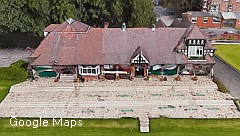
The pavilion
The name 'Cale Green Park' came into use in 1883 after Henry Bell (senior) purchased the lease of the farm. He immediately donated a large western section of the farmland, alongside the railway line, to the Stockport Cricket and Lacrosse clubs, on condition that the clubs pay for the conversion. A pavilion was built, in the 'arts and crafts' style of the period, and in enlarged form still served in 2018.
Cricket
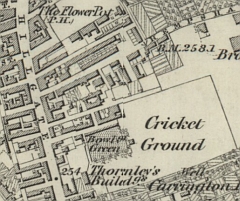
Stockport Cricket Club was founded in 1855. Its first ground was on land off Hillgate, owned by Lord Vernon and formerly farmed by John Bardsley who lived in nearby Cooper Street; he later gave up farming and became an estate agent. The farmland was covered by buildings, mostly terraced houses on a new street named Charles Street.
A memorable match at the Hillgate ground took place in July 1878 between a Stockport team and the first Australian touring team to visit Britain. A Stockport Cricket Club history records a move to a ground on Greek Street, although it is hard to see from maps of the time where this might have been, before settling in 1883 at its current (2018) home in Cale Green. Two bowling greens were created alongside the pavilion.
Over the years the club has moved through a number of leagues including the Manchester Association, Central Lancashire league, Derbyshire and Cheshire League and the club is currently a member of the Cheshire Pyramid System. Some famous players mainly in the Central Lancashire days, including Indian all-rounder Vinoo Mankad, who was accommodated for the season in a caravan by the ground. He became notorious for breaking the wicket at the bowler's end with the ball if a batsman had moved too far down the pitch, resulting in a 'run out' which many considered unsportsmanlike.
England fast bowler Brian Statham also played for Stockport before moving on to the Lancashire county team and test match fame with England.
Cheshire County cricket club, founded in 1908, also used the ground for some of their matches, between 1895 and 1953.
At the corner of the ground stands a memorial to the eighteen members who lost their lives in the two world wars.
Lacrosse
Stockport Lacrosse Club, which was founded in 1876 as a result of an exhibition tour organised by the Canadian "founding father of the modern game', William George Beers, also moved to the Cale Green site in 1883., with their own ground adjacent to the cricket ground. Founded in 1876 it can claim to the oldest lacrosse club in the world still in existence. Over the years lacrosse has been a popular game in the area south of Manchester, being taught in a number of schools.The public park
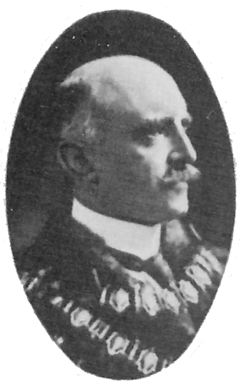
The public part of the the park came into being in 1902, inspired by Henry Bell junior (pictured above, as Mayor in 1908) who donated the land to the Council.
(The photograph used on Council information boards and leaflets appears to be of an un-related Henry Bell who lived in West Kirby.)

Mrs Emily Beatrice Bell, 1908
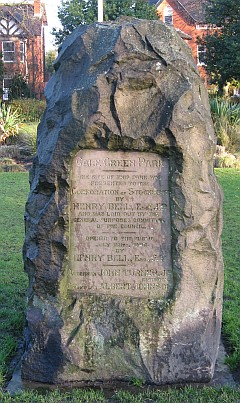
The stone in Cale Green Park commemorating Henry Bell's gift.
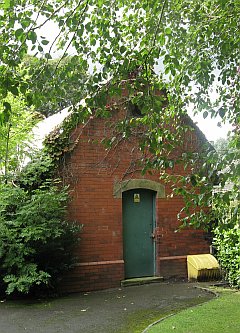
Among the trees at the north end of the park stands a small building, an original 'lodge' for the park-keeper, now serving as an electrical substation.
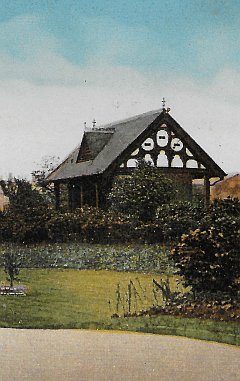
The other original building in the park is a shelter-cum-bandstand, seen above in an extract from an early colour postcard printed in Germany before 1914.
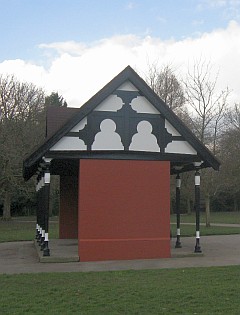
The shelter remains an important feature: the picture above shows it following refurbishment in 2018. The park, which also includes a recently refurbished children's playground, is supported and cared for by the very active Friends of Cale Green Park, who hold several events there each year.
Heath House
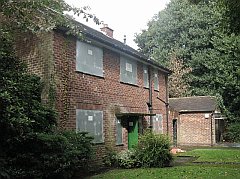
Some time around 1950, a house was constructed by the council in the park, near its northern edge, for a resident park-keeper, and given the name 'Heath House'', despite the existence of a house of that name in nearby Heath Road and the supposed former name of 'Heathfield.'
Arguably, building a house was in contravention of Henry Bell's conditions, but it served its purpose for many years. Its final occupants were the family of a 'Council employee associated with the management of Cale Green Park' in the words of a Council report of 2014, by which date the house had become empty.
Reportedly, the building had suffered from lack of maintenance, but it was proposed to offer it for sale. However, the sale never took place, the house remained safely sealed against vandals, and in a Council plan for 2017-2010 it was slated for demolition, which was finally carried out in 2018. The land is to revert to part of the public park; a published plan proposes a wildflower meadow.
Bramall Mount
The park was enlarged in the 1920s by the addition of part of the grounds of Bramall Mount (118 Bramhall Lane), a large villa built for the Rigby family, which had been donated to the Council.
The land for the house, a corner of Mile End Farm, was purchased by James Webster Rigby in 1851 from Lady Maria Davenport; at that time it was part of Bramhall township and adjoined the old route of Garner's Lane which formed the boundary with Stockport until 1901. Further land was purchased in 1860, after the original field had been bisected by the railway in 1857.
James Webster Rigby was a cotton waste dealer, with premises in Spring Bank Mill, a former cotton-spinning mill adjacent to Stockport Edgeley station. He died in 1868, and the house and firm passed down to his son Samuel Rigby (1846-1935), who moved with his mother to a smaller house in Nursery View, on Buxton Road in Great Moor, and later to 'The Pines', Cornwall Road, Harrogate, Yorkshire where he died in 1935.

From c. 1923 to 1934 the occupant of the house was Edward Hardcastle, a Stockport chemical manufacturer who may have been a relative of the Rigbys, as the name Jonathan Hardcastle appears on a document recording the 1851 sale.
On the death of Samuel Rigby the house with its land was passed to Stockport Council, including the plot on the other side of Bramhall Lane later known as 'Davenport Green'.
Bramhall Mount became the official residence of Stockport's Parks Superintendent, while part of the land, including the coach house adjacent to the railway was added to Cale Green Park.
By 1939, the householder, and Parks Superintendent, was Leslie Edgar Morgan (1897-1983), who lived at Bramhall Mount with his wife Amy E. Morgan and his father, the eccentrically-named Morgan Morgan (1869-1941), who had been the Parks Superintendent for the town of Crewe. Leslie had grown up in a house in that town's famous Queens Park. He went on to join the Civil Service as a Horticulturist on the Highways Engineering Staff, Ministry of Transport. He was awarded the OBE in 1960.
By the late 1950s, the house had been converted to four dwellings, and two additional buildings in the rear garden added another six homes, still occupied in 2018.
The frontage of the house, apart from the elaborate entrance, appears to have been altered from is original, which was probably 'rendered' white in the same way as Heathfield and had a different window layout. The current brickwork of the house frontage is certainly modern, not of the style used in the 1850s. Unfortunately, although many photographs can be found of the view down Bramhall Lane towards the house, in none of them is the house visible. A search of the Council archives may be in order.
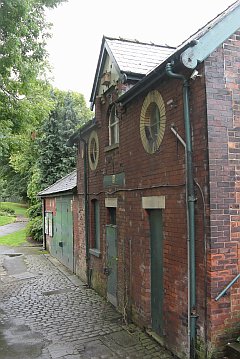
The coach house became a base for Park staff, including a mess room which is also used by the Friends of Cale Green Park to serve refreshments on the special event days.
A large part of the newly-acquired grounds was developed for sporting activities including a bowling green and tennis courts, which survive in 2018, unlike a putting green which long-time residents have recalled. In the 1990s, a hard court for netball and similar sports was created, in conjunction with Oriel Bank School which at that date operated in converted houses in nearby Davenport Park. The school closed in 2005, after which the court has seldom seen use for its original purpose.
The Farmers
Cale Green Farm was principally a dairy farm, all its fields being listed as grassland, the milk being sold around the local area. The 1841 census indicates that the tenant was Joseph Mayer, born in Stockport c. 1775. The Mayer family were established in Cale Green; there is a reference to a sermon by a 'Mr M. Mayer of Cale Green' in a newspaper dated 1786.
Joseph gave his occupation as Cotton M[anufacturer] suggesting that farming was something of sideline for him. He lived on the farm with a housekeeper, Mary Downham, and two domestic servants, as well as three agricultural labourers: George Barlow (age 25), Isaac Barlow (14) and Joseph Dykes (25).
Joseph Mayer was a person of some note in Stockport. He was a part-owner, with Alexander Rooth and John Middleton, in Hope Hill Mill, a spinning mill dating back to the late eighteenth century. (An earlier partner had been Alexander Bury). The mill, which stood on high ground, in an area known as Hope Hill, at the junction of Georges Road and Travis Brow, was demolished for the building of the Cheshire Lines railway - which has itself since disappeared leaving few traces - in the 1860s. The area is occupied in 2017 by a car showroom and some small business units, but Rooth Street and Bury Street survive on the site as a memory of the mill. (Meyer Street in Cale Green is spelled differently, but there may be a connection.)
Bury, Rooth, Middleton and Mayer were all staunch Methodists, and Joseph Mayer was much involved in the Sunday School movement, as a teacher and founding father of the large Stockport Sunday School building, which could accommodate 5000 pupils, and was said to be the largest Sunday School in the World. By 1851, Joseph Mayer had retired and was living, with his faithful housekeeper Mary Downham, and two other servants, Sarah Brandreth and Sarah Ann Robotham, at 31 Hall Street in Stockport. He died in 1857.

An enlargement of the Tithe map shows the farmstead, with the farm pond to the north; the building to the east, on the same plot appears to be the house named 'The Homestead'.
The 1851 census records the tenant of Cale Green Farm as Charles Robert Brady, aged 56, with wife Anne, and five children, his mother-in-law, a governess and two servants. Unusually for the time, he was not a Stockport native, having been born in Orford, Suffolk. The family had arrived in the Stockport area in 1837 when Charles obtained a post as agent and farm manager for Thomas Legh of Lyme Park. After a few years Charles took on a far of his own, Castle Farm on Mile End Lane.
Charles described himself in 1851 as a farmer of 42 acres employing two labourers, land agent and auctioneer. They had a large family: the 1861 census for Cale Green Farm lists their sons William Hollinshead Brady (age 27), Charles Alldis Brady (26), and Charles Robert Brady junior (14) and daughters Katherine Parr Brady (22), Helen Margaret Brady (21), Sarah Barbara Brady (19), and Anne Elizabeth Brady (17). The three elder girls were all described as Governesses. At this time, Charles was 'Auctioneer, Valuer and Farmer of 38 Acres'. The difference in acreage perhaps reflects the fact that the building of the railway, opened in 1857, had cut across the south-west corner of the farmland.
Charles Robert Brady died in 1864; his widow Anne died in 1868. By 1871 their son Charles Alldis Brady was the tenant. He gave his details as Land Agent, farmer of 42 (?) acres, employing four men. With him was his wife Harriet Holt Brady, children Charles Robert Brady junior (aged 4) and Edith Mary Brady (aged 2).
The Brady family was well-established in the area by this time as 'auctioneer, valuer, surveyor estate agent, and dealer in agricultural implements, seeds, &c', their office address - 17 Warren Street in the centre of Stockport - appearing many times in newspaper advertisements for house sales and similar. Charles Alldis Brady eventually moved with his family to the adjacent farm, known as 'Slain'. at that time in Cheadle township.
The tenant at Cale Green in 1881 was George Swinburne, occupation 'farm bailiff', born in East Drayton, Nottinghamshire c. 1832, with his wife Mary, daughter Lucy, and a servant. By 1891 he had left the area to become a farm labourer near Wath, Yorkshire.
In 1883 Henry Bell (senior) bought the farm and some of its land from the Carringtons, by which date some of the original farmland had already been used for the building of the Stockport - Whaley Bridge railway (opened in 1857), and for housing and sports use,
An auction notice lists the stock:
13 grand dairy cows in full profit, two draught horses, two pigs, poultry, two stacks and shed of excellent meadow and clover hay (about 40 tons), six tons oat straw, six tons swede turnips, and an assortment of modern agricultural implements.
The farmer in 1891 was Scottish-born John Gemmell, by which time the acreage was very much reduced, but the dairy farm selling its milk locally would still have been viable. He was still there according to an 1896 directory, but by 1901 Samuel Taylor and his second wife Hannah had taken over, destined to be the last farmers at Cale Green. The Taylors had moved to Stockport from the village of Butley Town in Cheshire with their daughter Mary.
Samuel Taylor died in 1908, around the same time that the farm site was earmarked for the construction of the new High School. However, Hannah and Mary continued farming, as a new farm was established as part of a housing development in Davenport, in the triangle formed by Oakfield, Beechfield and Elmfield Roads. The farmhouse, named 'Oakfield' is listed in 1911 with Hannah as farmer, daughters Mary and Jane as dairymaids, and a farm worker Isaac Timperley. Jane had moved to Stockport from Butley Town to help her mother. One imagines them making the rounds of homes around Davenport, perhaps dispensing it from churns carried on a yoke. Farming at Oakfield did not last long, as more houses were built, but the farmhouse, and an outbuilding which would have been its shippon, survive in 2018.
Auction at Heathfield, 1944
From a Stockport newspaper correspondent:
On Tuesday afternoon I wandered into "Heathfield", Cale Green, where an auction sale of the residue of household furniture and outside effects was being conducted by Mr. Marshall Bateman. It was not with the object if making purchases that I paid this call, but rather to revive memories of this residence and grounds so long the home of Mr. Henry Bell, whose beneficence to the town will keep his memory fresh for many years. The high wall surrounding the spacious grounds and the emergence of the the owner's handsome carriage and pair used to provide "Heathfield" with a mysterious interest to us small boys of Cale Green. And when subsequently I was permitted to enter the sylvan enclosure the experience filled me with awe and envy for the privileges which accompany wealth. The added years have removed such foolish thoughts.
Now "Heathfield" belongs to you and me, through the gift of Mr. Bell, and it remains only for our representatives on the Borough Council to out it to such use as would please the donor and the majority of the townspeople.
As to the auction, being the residue of the contents, there was little of interest to be obtained. Perhaps the most valuable article was a particularly handsome billiard table, which I am told cost £300. Clubmen will be surprised to hear that it was knocked down for £45 - and no purchase tax.
From the auction announcement on 15 February 1944:
Full size billiards table in magnificent carved oak frame, by Waring & Gillow; 6ft 6in burr walnut sideboard; oriental rosewood screen with silk work panel; two couches in tapestry; mahogany dining table ; mahogany and carved teak pedestals, carved oak side table; walnut toilet stands; chest of drawers, brass and iron bedsteads; toilet ware; adjustable bedside table; bed rest; mahogany display and occasional tables; curbs; decorative ornaments; mirrors; oak case mantel timepiece; baragraph by Thomas Armstrong; a few pieces of solver and electro plate; bronze figure ornaments; small quantities of glass, china and dinner ware; kitchen utensils; food safe; ice chest; pitch-pine cupboard; two Green's mowing machines; garden roller; garden forcing frames and lights; T. and G. lean-to shed with corrugated iron roof, ten garden seats, approximate 2,000 plant pots, sizes 3in. to 24in; iron 2-wheel dandy and other items.

'Wellington's Stables'
The white-painted house which in 2018 is numbered No. 5 Cale Green was originally a terrace of three cottages, Nos. 3, 5 and 7. The building possibly dates from the 1790s; the Land Registry records that Joseph and John Carrington (members of the Carrington hatting family) leased the land from William Nicholson of Springfield House, Liverpool in 1799. The Nicholson family had been landowners in the Stockport area since a much-earlier William Nicholson purchased Wood Hall in Reddish in 1551.Lady McDougall was Hannah Roe, whose first husband was William Nicholson and her second husband, from 1844, was Colonel Sir Duncan MacDougall (1787-1862). The two men were acquainted through their involvement in the creation of the Lancashire Militia.
The tithe records of the time show the owner as 'Lady McDougall' and the 'Occupier' as Samuel Christy.
At some stage, the Carringtons transferred the lease to Samuel Christy, who was the head of the Christy's hatting firm, based on a works on a site in Hillgate which was also leased from Lady McDougal.
The cottages, like others in Cale Green were rented by workers in the local hat industry. Samuel Christy lived in a large house in Poynton, several miles from Stockport.
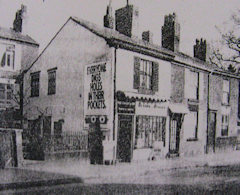
At some time, probably in the 1930s, No.3 Cale Green was altered to include a tobacco and confectionery shop, which became a popular 'tuck shop' for the pupils of the nearby school.
The picture above dates from 1980, by which time the two other cottages had fallen into disrepair, and the Council was proposing to compulsory purchase the whole terrace, and replace it with new flats.
However, Mrs Mary Bird, who ran the shop, objected strongly to the proposal, invoking the legend that the historic building was once used as stables for the Duke of Wellington. The Local History Librarian was consulted and suggested that there was a fashion for naming buildings after Wellington, but doubted whether the great general ever visited Cale Green.
With support for retention from local community groups, the decision was passed to a Department of the Environment inspector who ruled that Nos. 3 and 5 should remain. as they 'form an attractive part of the street scene ... well worth attempting to keep and enhance'.
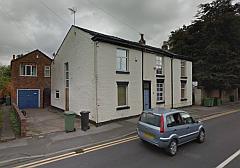
The whole building was retained, but without Mrs Bird's shop. We understand that there was a fire during renovation work. Close inspection of the building shows 'stretcher bond' brickwork on part of the frontage, merging with the old brick on the ends. Stercher bond was never used for buildings in the 1790s, suggesting a drastic rebuild recent times.
The building was sold in 1985 and by 2017 (above, from Google streetview) it had become three homes, with access to the outer two through doors in the end gables, but the row is still very much recognisable and does indeed enhance this historic area.
The Davenport Club
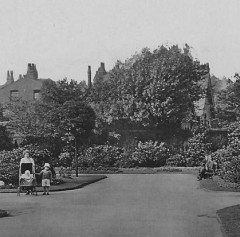
The building just visible behind the tree in this postcard extract of the northern corner of the Park was the home of the Davenport Club on Heath Road, which was built in the Edwardian period, as a meeting place for the businessmen of Davenport to meet, play snooker, and listen to educational talks. Can any reader tell us more?
The Club was still operating in the 1980s, but by 1992 the building had been demolished, replaced by a new purpose-building for Happy Day Nursery, a business formerly in a converted house at 136 Bramhall Lane which had been operating since the 1970s. In 2017 the business was purchased by the Kids Planet chain of nurseries.
Joan Bakewell on Stockport High School, 1940s:
The rules were relentless, dragooning us in every particular of behaviour ... Uniform even meant the same indoor shoes for every pupil; hair-ribbons had to be navy blue.
The heaviest burden was the no-talking rule: no talking on the stairs, in the classroom,in the corridors, in assembly - anywhere, in fact, except the playground. Each whisper in the corridor, each hist of communication on the stairs was quashed, conduct marks apportioned and lines of Cicero copies out in detention.
(From Joan Bakewell, The Centre of the Bed: an Autobiography. London: Hodder and Stoughton, 1994.)
Note about Henry Bell in Old Trafford
The 1891 census lists Henry Bell senior living at 470 Stretford Road, Old Trafford.
It was the house later numbered 472, one of a semi-detached pair of houses known as 'Farnham Place'. The neighbouring house was the home of a doctor, John Kennedy. By the 1930s the two houses had been converted to three shops - by 1961 no. 472 was Hullard Hall post office - and were demolished in the 1980s, replaced by a new housing development. The reason for the number change is that in the late 1890s a new row of shops was built on an empty plot alongside, numbered evens 456 to 470. (The new no. 470 was form some years a cycle shop which also acted as an office for the Manchester Clarion Cycle Club.)
Sources
Stockport Library image archive
Cheshire Tithe Maps online
Stockport Heritage Library press cuttings, and files on the Carringtons, Henry Bell, Highfield and the High School.
The British Newspaper Archive and Ancestry.co.uk websites
Terry Drabble. 'Hope Hill Mill'. comment on Rhodes Family Website.
Mike Ogden. A History of Stockport Breweries. Neil Richardson, 1987.
Penny McKnight. Stockport Hatting. Stockport MBC, 2000.
'An Old Felt Hatting Company'. Stockport Advertiser Centenary Number, 31 March 1922.
List of nineteenth century University of London examinees, University of London Archives.
Josephine Sanderson. Stockport High School for Girls 1894-1974. Photocopy on file in Stockport Heritage Library.
Stockport Cricket Club history website on archive.org
Manchester Mercury, 1 August 1786.
Burke's Genealogical and Heraldic History of the Landed Gentry, Volume 2, London: Colburn, 1847 (Google books).
Thanks
This piece could not have been completed without the help of:Harold Cataquet of Friends of Cale Green Park
Staff members of Heathfield: Richard Barraclough for allowing a visit to the building, and Lynne Oversby for her encouragement and the excellent photographs.
Colin Wilks of Stockport Cricket Club who kindly shared with us the Club archives; also Peter Chappell and David Alison for Cricket information.
Michael Brady for assistance with Brady family history.
Contributions are very welcome:
info@davenportstation.org.uk
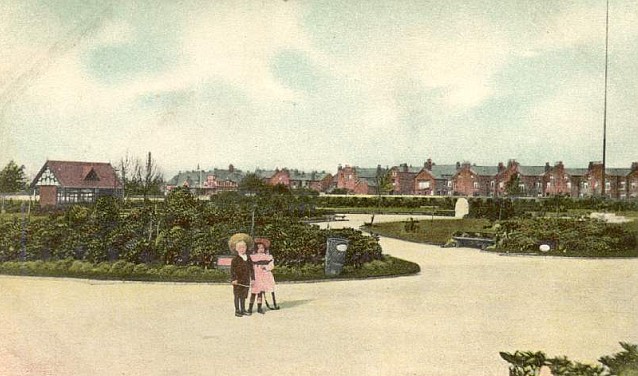
The Edwardian park which is such a welcome feature of the Davenport / Cale Green area once was part of a working farm. In this feature we tell some of the story of that farm, its families, and the development of today's landscape.
There is more to be told about this area: contributions are very welcome.
Cale Green Farm
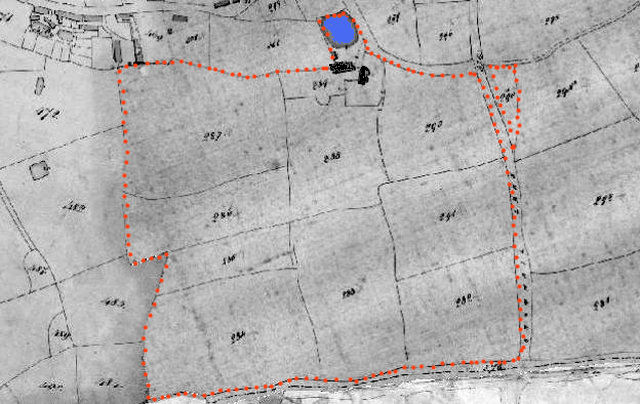
The area of Stockport known as Cale Green is said to be named after a John Cale, who built the first house there, but information about that gentleman is hard to locate. A large part of the area was occupied by the pastures of Cale Green Farm, whose farmhouse was on the site of the large school building which stands there in 2017. The Tithe Map extract above dates from the 1850s; the extent of the farm at that time is marked in red. Bramhall Lane runs north to south on the right-hand edge of the extract, with the the original course of Garners Lane at the bottom. Note the small triangular area to the east of Bramhall Lane, which can still be traced by the back garden walls of 119-155 Bramhall Lane.
Historically, Cale Green lay on the southern edge of the township of Stockport, adjacent to the boundary with Bramhall which until 1901 followed the line of Kennerley Road and the original route of Garner's Lane. To the west was the boundary of Cheadle Bulkeley township. This farm would been worked for centuries: some sources say it was once part of the lands of the Davenports of Bramhall Hall, but by the time of the tithe record, holdings of the Davenport family within Stockport township had been sold. We have not traced any pictures of the farm buildings, although some surely must exist, even if only from the time of their demolition. The farmhouse was probably a much-altered timber-framed structure. For more history of the farm, see The Farmers below.
At the time of the tithe survey the owner of the farm was listed as 'Trustees of Dr Thompson'. Thomas Thompson had recently purchased the farm on behalf of the Carrington family, possibly the previous owner was local landowner Lord Vernon, but we are not certain. In 1883 ownership of some of the land passed to the Bell family, as we explain in the sections that follow.
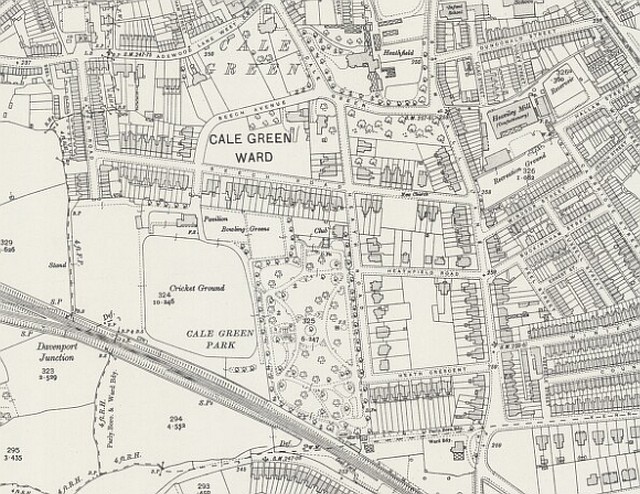
This map dated 1910 shows (under the words 'Cale Green Ward' and south of the railway) what little remained in agricultural use by c.1905, following the intrusion of the railway in 1857, the creation of the lacrosse and cricket grounds in the 1880s, the network of new streets, and the opening of Cale Green Park in 1902. The small area including the farmhouse, between the new streets Beech Road and Beech Avenue, was earmarked as the site of the Stockport High School for Girls, and an isolated area to the south of the railway later became part of a council housing estate. At the top of the extract, north of Cale Green, and never part of the farm, is the large villa 'Heathfield' surrounded by its extensive range of conservatories. The pond (said to have been the site of 'ducking stool' punishments) has been filled in, but the two pairs of semi-detached houses on its site have yet to be built.
The old boundary of Stockport is marked, but since 1901 it had been simply a ward and constituency boundary as the Davenport area to the south had been absorbed into Stockport. Garners Lane had been diverted in the 1880s to cross the railway by the station bridge; its original course, which followed the Stockport / Bramhall boundary, ran behind the gardens of Heath Crescent. The triangular area between the boundary and the railway formed the grounds of Bramall Mount - see left-hand column.
Heathfield

Across the road from the farmhouse stood - and still stands in 2019 - a large villa shown on an 1870s map as as 'Heath House' but always listed on census records as 'Heathfield', built circa 1848-50 for Samuel Ratcliffe Carrington, born in Marple in 1811, partner in the nearby hat works. He leased the land from Lloyd Hesketh Bamford Hesketh, whose family, related by marriage to the Davenports, owned much land in the area.
The house is not shown on the Tithe map, but its plot is described as 'house and pleasure garden.' Carrington lived there in style with his large family and servants, and became the owner of much land in the Cale Green area, including eventually the whole of Cale Green Farm.
Samuel was a significant figure in the history of Stockport, especially the Cale Green area. He and Thomas continued to develop the firm with became 'S & T Carrington.' He was a religious man; he attended the Hanover Congregational Chapel in Stockport, and in the words of his obituary, he 'took the greatest interest in the charitable and benevolent institution of the town ... his purse was always open to the demands of religion or philanthropy.' He was one of the founders of the Stockport Town Mission, whose members engaged in house-to-house visits, as well as attending the Infirmary and Workhouse.
In 1848 he married Christiana Thompson in Taunton, Somerset. Christiana was a daughter of Thomas Thompson (1785-1865), a wealthy London stockbroker who had retired early to live in style in a sixteenth-century manor house, Poundisford Park, Somerset. Born in 1823, Christiana was one of eight children, including her twin sister Elizabeth, and Jemima Thompson who under her married name Jemima Luke wrote a famous hymn 'I Think When I read that Sweet Story of Old'. Thomas Thompson was a devout Congregationalist Christian, heavily involved in missionary work; his life and work is documented in a biography by his daughter.
Perhaps the old Carrington residence was not considered appropriate by Thomas Thompson for the life-style of a member of his family, as it was on her marriage to Samuel that the large villa 'Heathfield' on land across the road from the factory site was commissioned. In addition, it seems that Thomas Thompson purchased for the couple the land and buildings of Cale Green Farm, which is listed in the 1850 Tithe records as owned by 'Trustees of Dr Thompson'. This would, as well as being a significant 'wedding gift', provide an income from rental and a 'country estate' safe from housing development.
Heathfield appears in the 1851 census with the family in occupation: Samuel (aged 39), his wife Christiana (25), daughter Charlotte Ellen Carrington (1) and son William Edward Carrington (2 months), plus servants Sarah Hamilton and Maria King. Samuel's mother Ellen continued to live on the factory site in Cale Green; she was still there, aged 83, in 1861. The 1861 census for Heathfield records Samuel, Christiana, sons Walter Thomas Carrington (7), Samuel Herbert Carrington (5) and James Yates Carrington (4), daughter Julia Christiana Carrington (infant), Cook Jane Bagnall, Housemaid Martha Jones and two 'under-nurses' Mary Anne Leigh and Elizabeth Dale.
The household in 1871 was Samuel Ratcliffe Carrington (age 59), Magistrate and Hat Manufacturer employing 259 hands; son Walter Thomas Carrington (17), scholar; daughters Julia Christiana Carrington (10) and Mary Elizabeth Carrington (7) and son Cephas Howard Carrington (5). Serving them were Sarah Plant (41), Head Nurse; Sarah Ninil (?) (36), Cook, Esther Rutter (28), housemaid; Sarah Evans (27), Waitress; Emma Stead (17), Under Nurse. Son William Edward Carrington (20) was, on the Census day, staying at the Palace Hotel in Buxton along with his sister Charlotte and their mother Christiana.
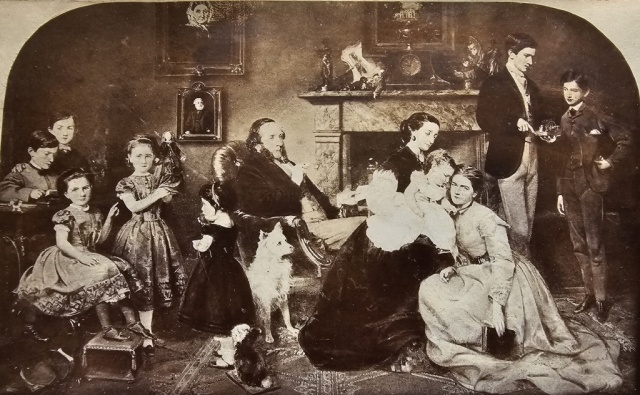
In 1867 artist William Owen Harling (1813-1879) painted Samuel Carrington and his family, seen around the fireplace in Heathfield. If anyone knows the whereabouts of the work today, please contact us.
The Carrington family dispersed: Samuel Carrington was living at 'Eskdale' in Ainsdale near Southport when he died in 1883.
By 1881 'Heathfield', and a large part of the farm, had been sold to Henry Bell, a wealthy local brewer, but the Carrington family continued to commission housing on the parts of the farm adjacent to Bramhall Lane, and Beech Road, Heath Road, and Heath Crescent came into being. The name 'Heath Crescent' for a short, straight, road seems to imply an intention to extend, but this never happened.
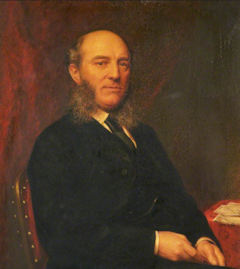
Henry Bell, who was a sports enthusiast and philanthropist, purchased the western part of the farm after Samuel Carrington's death in 1883, and donated land to Stockport Cricket Club and Stockport Lacrosse Club. The portrait reproduced here, dated 1878, is owned by Stockport Council, credited to local artist Allan H. Fox, but it may be by his father Augustus Henry Fox. Both lived and worked in their home at 36 Adswood Lane West, a short distance from Heathfield. See also our Tasmania Cottage feature. Henry Bell senior died in 1891.
Henry stayed in Heathfield until his death in 1943, and was the originator of the public Cale Green Park as we know it today. (See Bell's Brewery below for more about the Bells.) He also continued to sell land for housing, including an new street created in 1900 which became Heathfield Road.

The view of Heathfield from the drive on a winter's day. Above c. 1910. Below, March 2018.
Henry Bell junior made over Heathfield to Stockport Council in 1936 with a proviso that after his death it must be used for educational purposes. Following his death in 1943, there was some discussion between Council departments about its future use, until it was decided to adapt the school as an annexe to the nearby Stockport High School for Girls. It opened in its new role in December 1946.
Additional buildings were erected in the grounds: a kitchen and dining room in place of the orchard, and to the north what appear to have been pre-fabricated classrooms on the same T-shaped plan like those built on the playground of Cale Green Primary School nearby. A sports field was developed in the grounds, between the house and Bramhall Lane; old maps and aerial views show that even before the School took over the house it featured a running track, which has since disappeared.
The field has never been built on, even along its frontage to Bramhall Lane, according to the terms of Henry Bell junior's gift. An open area on the opposite side of the road known as Cale Green was also part of Heathfield's estate, and has been retained for the benefit of the community, and is known as Bell's Paddock, an area of mature trees with a profusion of flowers in the spring. An unlikely local legend has it that the horses which pulled Bell's brewery 'drays' were buried there.
In 1974 a reorganisation of secondary education led to the merger of the school with another girls' school, Fylde Lodge: see the section on Stockport High School below. Heathfield was then used, along with the main school building, as Davenport Lower School and later as an annexe of Stockport College of Further Education. When no longer needed by the College the Council looked for another use compatible with Henry Bell's bequest. By the 1990s the National Health Service were looking a replacement for the 'Darwen Wards' in the old St Thomas's Hospital where conditions for recovering mental health patients were described as 'gloomy' and 'prison-like' with patients sleeping in open wards. The under-used Cherry Tree Hospital was considered, but in 1995 the decision was taken to take over Heathfield from the Council and transform it into an 'oasis of calm' with individual bedrooms for the patients.
The NHS took on the building in 1997 and transferred it to a Huddersfield-based property company in a 'lease-back' arrangement. It was re-built, involving considerable alterations to the buildings, as a rehabilitation centre for mental health patients as part of Stockport NHS Foundation Trust; in 2006 its management was transferred to the Pennine Care NHS Foundation Trust, which provides mental health and other specialist services across the Manchester city region. As Heathfield House Mental Health Rehabilitation Centre it still flourishes in 2025.
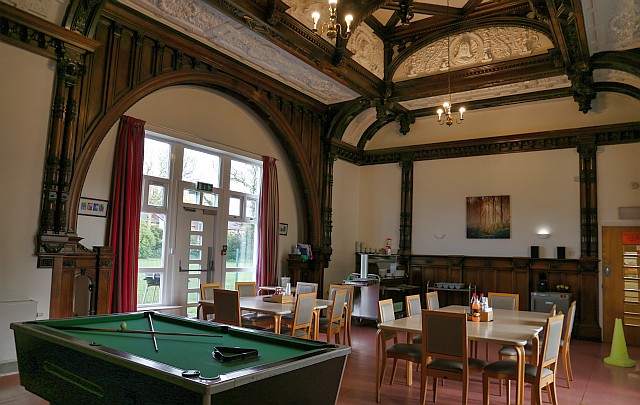
The remaining original part of the main house is as administration offices. Most of the interior is much altered, the buildings themselves have been modified and extra buildings have been added, but the room pictured above, attached to the main house, which is used by the Centre as a dining room, retains its original features including wood carving and an elaborate plaster ceiling including relief portraits of famous figures of the past such as Shakespeare and Demosthenes. The room gives no clues to its original function. Was it perhaps a billiards room? A full-size billiard table was among the items auctioned when the house was cleared.
To quote from a 2015 brochure:
Heathfield House is a mental health recovery and rehabilitation unit that opened in 2006 and offers 19 beds and three self-contained two studio flats. It is based in a residential area of Stockport. The unit provides intensive mental health rehabilitation and recovery in a community based step-down environment. It is for men aged 18 to 65 years, who have a severe mental illness, such as schizophrenia or bi-polar disorder, and who have been difficult to engage in the past. The unit offers a two year pathway and service users are discharged into appropriate community-based supported accommodation or independent living.The Council have retained ownership of the playing field, along with what was originally Heathfield's stable block and coach house, which has its own driveway from Adswood Lane East, and also two cottages adjacent to the drive which were also part of the gift. In the 1990s there were suggestions that it could be converted to housing, but it was pointed out that this would meet Henry Bell's conditions requiring community use. The building, which had suffered much vandalism, was repaired for use by community groups, and in 2025 is the base of SPARC - Stockport Progress and Recovery Centre (formerly Stockport Day Centre). This is a local voluntary organisation providing support to adults in the Stockport area who experience mental health problems.
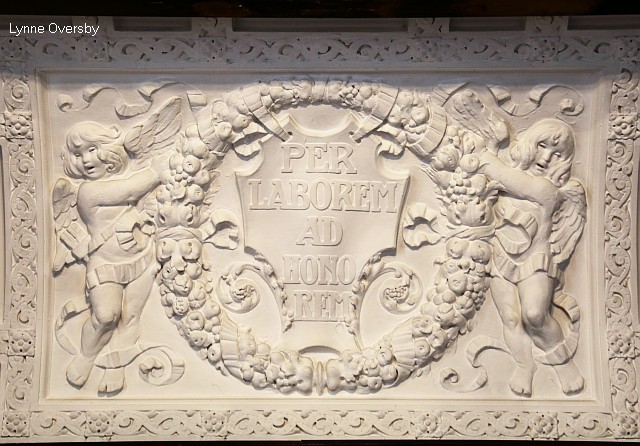
Per Laborem ad Honorem: Through work to honour.

Aerial views: 1927 (above) and 2017 (below). The main house was once twice its present size.

The modern buildings are the residential accommodation. A single-storey block replaced the rear part of the house, we believe this work was done when the NHS took over.
The Homestead

In 1872 a plot of land immediately south of the farmhouse, containing a three-storey Georgian-style house named 'The Homestead', was sold (or perhaps leased) by Samuel Ratcliffe Carrington to a Henry Smith. We cannot be certain of his identity, due to the common nature of his name, but he was probably Henry Smith, brewer, of the Waterloo Brewery in Hall Street. The house was surely extant before 1872, as it appears on the Tithe map, but its history before 1872 is obscure. Perhaps it was used by members of the Carrington family, or was included as part of the farmstead in earlier records? A note with the photograph says it was 'the first house in Cale Green, the home of John Cale' but we cannot find any evidence that such a person existed.
By 1881 the resident was Thomas Kirk, born in Epworth, Lincolnshire, who in 1878 had lived nearby at Beech House in Adswood Lane West. He is recorded in 1883 as a shirt manufacturer. He died there in 1899; the next resident was an electrical engineer, John W. Fletcher.
In 1911 the house was empty, but by 1914 the householder was a Robert Hunt, and a directory for 1923 lists Mrs Hunt - presumably his widow - as occupier. He may have been Robert Hunt (1849-1920) the head of a lithographic printing firm, who had previously lived in Acomb Street. Manchester. The photograph above is dated 1924; by the 1930s the house had disappeared from the map, leaving an empty space which remained for many years, used for a while as a playground, before it was re-used in 1994 by the nearby school for a new sports hall.

The gateposts remain as a reminder of the lost house. The Homestead was the precursor to many more houses which in the following decade were to cover much of the eastern part of the farm. In 1889, a section of the original plot was sold to builder Henry Wild, who erected two pairs of semi-detached houses, 10-12 Heath Road and 14 Heath Road/26 Beech Road. A resident of note at no.10 in 1902 was the Reverend Benjamin Charles Constable, Minister of Stockport Unitarian Church. No. 12 in 1911 was a boarding house for two of the teachers at the Girls High School; by the 1950s 10 and 12 had been purchased by the neighbouring school and combined into a school clinic; later they were used as a sixth form common room with two classrooms, but were eventually demolished to make way for a new Preparatory department. No. 14 was also a boarding house in 1911.
The Cottage
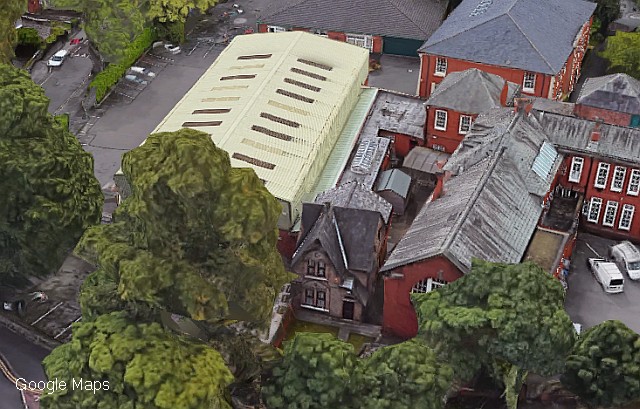
Although it is very much still in existence and occupied, the little house known as 'The Cottage' or 'Hillcrest Cottage' tucked amid the school buildings on Beech Avenue has proved hard to research.
The name 'Hillcrest Cottage' post-dates the arrival of Hillcrest School in the 1980s, whilst the name 'The Cottage' does not appear on maps until the 1950s. The 1911 census lists a 'Lodge to Girls High School' in its position on Beech Avenue, although a building in the same location is shown on a map dated 1910 alongside the farm buildings, pre-dating the school. The occupants of the 'lodge' in 1911 were Edward Perkins, school caretaker, and his wife Clara.
Could it be that it was built to re-house the Taylor family, before their farm was moved to Beechfield Road? Any information about the history of this house would be very welcome.
Carrington's Hats
Stockport was known for many years as a centre of the hat-making trade. There are records of hatting in the town as early as 1650, as a small-scale cottage industry. It is claimed that the town's first hat factory was set up in 1710 by Anthony Carrington, born in 1679 at Bugsworth Hall Farm in Derbyshire. As the youngest son of his father James, he left home to 'seek his fortune' and set up as a hatter in premises in Adlington Square, Stockport, an area since much altered and absorbed into the Merseyway precinct as Adlington Walk. How he learned the trade does not seem to be recorded. He certainly seems to have found his fortune, as by 1731 he was Mayor of Stockport, although the office of Mayor in those days was rather different to today.Anthony died in 1762 and the business was continued by his 'kinsman' William Carrington (1738-1800) who was followed by another William Carrington (1769-1832) who bought land in Cale Green and built a house there. it is said that the cellars of the house were initially used for hat-making activity, and as business developed, a factory was created on the adjacent land. An 1842 plan shows the house and factory occupying the area bounded by Shaw Heath, Mayer Street, Wood Street (later renamed Lytham Street) and Adswood Lane West (described as Cale Green.) The works never expanded beyond this area. He brought into the firm into the firm his son by his first wife, another William Carrington (1795-1835). By his second wife he had two sons, Samuel Ratcliffe Carrington (1811-1883) and Thomas Carrington (1813-1873) who became partners in the firm.
After his brother Thomas Carrington died in 1873, Samuel took for partners his sons William Edward Carrington and Walter Thomas Carrington, and carried on the business as S.R. Carrington and Sons, which became a limited company in 1908, after the death of Walter Edward Carrington that year, with William Edward Carrington as Managing Director.
William Edward Carrington (1851-1930) was, like his father, a man of many parts. Educated as various private schools, including a short time in Paris, followed by study at Owens College, Manchester, which at that period was not awarding its own degrees, but was approved as a provincial examination centre for matriculation candidates of the University of London; he matriculated in 1868 aged just 17. A life-long bachelor, he had an interest in scientific matters, and was an early pioneer of cycling; in 1880 he was reported to have travelled from Stockport to Chester on a 'velocipede'. He served as a Magistrate, a Councillor, and a Committee member of Stockport Infirmary, A Congregationalist like his father, he served for 35 years as Superintendent of the Cale Green Institute and Sunday School in Meyer Street which had been built by his father and uncle, eventually donating the building (which survives in 2017 in an altered form) to the Church.
He lived in the old house at 8 Adswood Lane West until his death in 1930; the 1901 Census catches him in the Tudor Hotel, London, but 1911 census lists him in Cale Green with a cook / housekeeper, Elizabeth Smyth, and a housemaid, Florence Jones. On his death, the management of the hat factory was carried on by men outside the Carrington family.
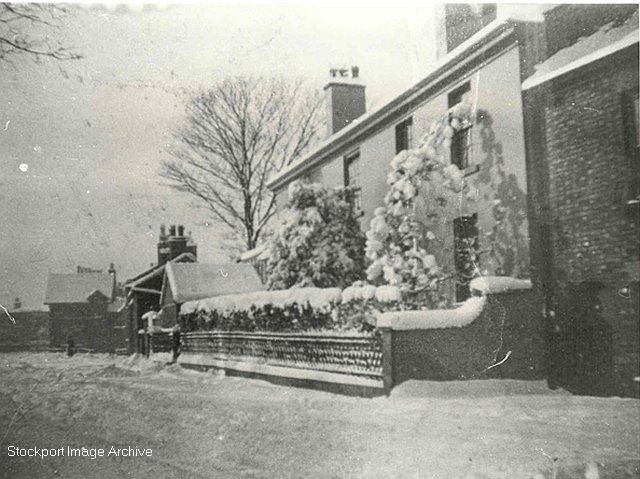
This winter scene is the only known clear photograph of the Carrington house in Adswood Lane West. The address of the works was 4-6, Adswood Lane West, and the house was apparently no. 8. It was demolished at an unknown date after W.E. Carrington's death in 1930. The photograph suggests that there was another house in the foreground, but a 1931 aerial view shows the house closely surrounded on two sides by factory buildings.
The 1851 census has Ellen Carrington's house as '18 Cale Green' which would possibly match this house if addresses on the part of Adswood Lane West next to the factory were classed as 'Cale Green' at that time.

The Grenville Series postcard above, from c. 1910 looks towards Cale Green from the corner of Adswood Lane West and Lytham Street. The Carrington house can be glimpsed beyond the tree. The two buildings in the centre are clearly very old...

... they have survived, in much-altered form, into the twenty-first century. This picture shows Adswood Lane West in 2017. The tall office building of Travis Perkins builders' merchants stands on the site of the Carrington house.
Walter Thomas Carrington (1854-1908) who managed the firm jointly with his brother William, served in the 20th Rifle Volunteer Corps, rising to the rank of Colonel in 1889 as the commanding officer of the 4th Cheshire Volunteer Regiment. He also studied at Owens College for a University of London qualification. In 1893 he married Lucy Ellen Battersby. Battersby is the name of a famous Stockport hatting firm, but Lucy was born near Liverpool and before her wedding and move to Stockport she was living with her widowed mother, also called Lucy, in Wolverhampton, in the same Tettenhall Road district as his sister Charlotte. Perhaps the sisters were friends with Lucy. Walter was involved in Stockport local politics as a committed supporter of the Free Trade movement, although he never achieved his ambition to be an MP.
Their married home was the western of the two very large semi-detached houses known as 'Cale Green Villas' which had been constructed in 1869 on land at the corner of Cale Green and Adswood Lane West. In a separate feature, Cale Green Villas: a house history, we trace the complex history of these buildings. It seems likely that they were commissioned as homes for the two brothers and their families, but William didn't want to move from the old family, while Walter waited until he married in 1893. The houses were rented to a series of tenants.
In 1901 the household included their daughter Joan Shelley Carrington (age 5), Georgina Ratcliffe Carrington (4), Nurse Annie Sykes (36), Under-nurse Lenora Kitchen (18), waitress Agnes Davenport (20) and cook Lily Meachin (18). After Walter's death, Lucy Carrington moved to Malvern Wells, Worcestershire, where she lived with two servants while the two girls attended the Abbey school there. Joan Shelley Carrington stayed at Malvern, where in 1934 she married Richard D.B.W White; the 1939 register found them in London where he was a Musical Director. She died in London in 1958. Georgina also remained in Malvern, marrying a 'dental mechanic', Joseph Russell, also in 1934.
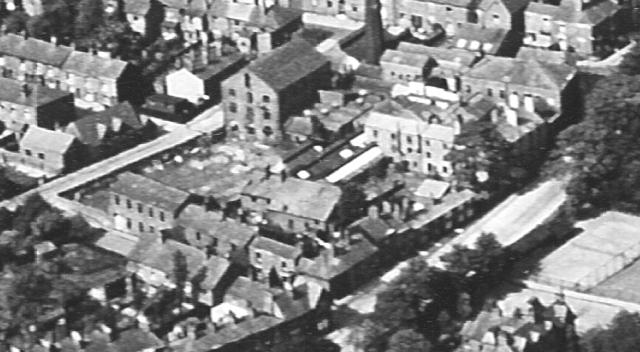
An (over) enlargement of a 1920s aerial view shows Carringtons' factory, the old cottages and the Carrington house, with its tall chimneys, nestling between factory buildings.
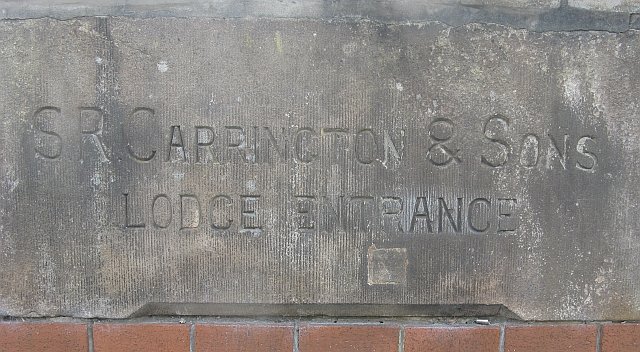
Carrington's remained a relatively small business, employing no more than 240 people and specialising in quality felt hats. As the industry contracted and companies merged, the Cale Green factory was abandoned in 1955 in favour of a share of the Sutton and Torkington factory in Lord Street, near Stockport Town Hall. Happily, a stone from the original works lodge can be seen in the rebuilt brick wall near the corner of Adswood Lane West and Shaw Heath.

Various buildings on the Cale Green site survive in industrial use.; the picture above is from 2018. Part of the site is used by builders merchant Travis Perkins, whose modern administration building stands on the site of the Carringtons' eighteenth-century home.
As mentioned above, from the 1950s onward, the public demand for felt hats declined, with drastic effect on Stockport's hatting industry. In 1959, Carringtons purchased the hatting firm James Bevan & Co. based at Pitt Street works in the Manchester area's other hat-making centre, Denton, and appear to have transferred their manufacturing there. The shareholders of Bevan & Co received £25 per share, valuing the firm at £25,000. The firm was renamed Carrington-Bevan, which itself was later merged into the Joseph Howe and Sons hatting business in Amelia Street, Denton. Both companies went into liquidation in 1975.
Sutton and Torkington moved into the Hillgate premises of Christy's, who took over the company in 1964. The Lord Street site was cleared for the erection for Stockport Council of 'Stopford House', a concrete office building in the 'brutalist' style, completed in 1975.
In 1966, five surviving firms - Battersbys, Lees and Christy's of Stockport with Wilson's and Moore's of Denton - merged as Associated British Hat Manufacturers, but decline continued until in 1997 the Hillgate works closed and felt hat manufacture in Stockport ceased. Its golden age is commemorated by a Hat Museum in a former hat works on Wellington Road South.
Samuel and Christiana Carrington's other children
Charlotte Ellen Carrington (1849-1905) married John E. Morris, of a firm of Manufacturing Chemists in Wolverhampton, where they were living in 1881, sharing a house at 83 Tettenhall Road with Charlotte's sister Julia Christiana Carrington. (John E. Morris was a son of Sir John Morris, who founded the chemical firm and while Mayor of Wolverhampton was knighted by Queen Victoria in 1886. The family home was a large mansion called Elmsdale Hall.)
Samuel Herbert Carrington (born 1856) followed his brothers to Owens College for a University of London qualification, then emigrated to America where he died at an early age
James Yates Carrington (1857-1892), Samuel's fourth son, is another member of Stockport's artists to be chronicled on our site, although he mostly worked at his London studio in Hill Road, St John's Wood. he studied under Stockport's best-known art teacher of the time, J.H.E. Partington, and thanks to his father's devotion to the best education for his sons (if not his daughters) went on to study at the Academy of Fine Arts in Munich. His ambition was to be a landscape painter, but he accidentally achieved fame with a portrait of a dog - his fox-terrier, Teufel - which was followed by many more, along with stories of Teufel's activities which appeared in various magazines. He died in London aged just 35.
Julia Christiana Carrington (1860-1913) moved with her sister to Wolverhampton where she married John Perks, 'edge tool manufacturer' of John Perks & Sons, Monmore Green Works, Wolverhampton. They raised a family with the help of two servants at a house in Clifton Road, and later in Old Hill, Tettenhall.
Mary Elizabeth Carrington (1864-1936) married Walter Lawrence Swithenbank, Wimbledon-born son of a hat-trimming merchant, a in Stockport in 1896; in 1911 they were living at 'Greenhill' in Bramhall with their two daughters. All the family attended William Edward Carrington's funeral in 1930.
Cephas Howard Carrington (1865-1896) was named after Cephas Howard, husband of Samuel's sister Mary. He appears to have had artistic leanings , describing himself in 1891 as 'Superintendent, Decorative Arts Guild.' Educated at boarding school Leamington College, his life was tragically short: he died in 1896.
Bell's Brewery
Henry Bell (1825 - 1891), head of the second family to reside at Heathfield, was not a self-made man from a poor family; he was a member of the 'landed gentry', being the son of Henry Wade Bell (1793-1855) of Portington Hall, near Howden in the East Riding of Yorkshire. The family were Conservative in their politics, and Methodist in their religion. Henry Wade Bell's father inherited 1/3 of the Manor of Portington from his father (211 acres and Portington Grange). This was sold after his death in 1841 with Henry Wade Bell renting the Caville Hall farm where he died in 1855.'Our' Henry Bell - Henry Bell senior for our purposes - gave his birthplace as Spaldington, a hamlet not far from Portington, but by the 1841 census he was living at Portington with his father Henry. His Stockport newspaper obituaries suggest that he grew up at Caville Hall. Later, he was awarded his own farm and estate, Milford Hall in North Milford, in the North Riding of Yorkshire, where he was recorded in 1861 with his wife Mary, his one-year-old son Henry, three farm labourers and three domestic servants. Milford Hall, now known as North Milford Hall, is a Georgian building now Grade II as a historic structure.
Meanwhile, in Stockport, a brewery was established on site alongside Hempshaw Lane, making use of the water from the adjacent brook, in 1835 by Avery Fletcher, a brushmaker of 44 Great Underbank. By the 1840s it had become a large operation, but for some reason Fletcher gave it up, and by 1850, following the sale of the shares a sort of lottery (see the press cutting in the left column), it became the property of Joseph Smith of the Eldon Brewery and Henry Bell 'of Portington, Yorkshire', and by 1851 was trading as Smith & Bell. A record in the 1851 census suggests that Henry Bell was living in the house at the Brewery; also listed there was Thomas Fearn, an associate of Smith's from Sheffield, with his wife Elizabeth and son George.
In 1872 Joseph Smith retired, and Thomas Fearn's son George joined the firm which came Bell & Co., with Henry Bell as Chairman. By then Henry had left his Yorkshire farming life and relocated to Stockport to be close to the brewery, setting up home at 37 Greek Street, a fashionable Victorian semi-detached which can still be seen in 2019, recently converted to ten bed-sitting-rooms after a long period of business use. By 1871 he had three sons: Henry (aged 11) and Alfred (9) born in Yorkshire, and Thomas (7) in Stockport. His wife Mary had died in 1863, and two servants - a cook and a general servant - provided for the family.
The business prospered and by 1881 the family had taken on the Carringtons' villa in Cale Green, 'Heathfield', and gained several more servants. Henry was a Conservative member of Stockport Council from 1868 to 1883, and served as Mayor for two years from 1878. He stood for Parliament, but Stockport's voters and two MPs remained staunchly Liberal. He was also a Justice of the Peace.
Henry's eldest son, also named Henry Bell, continued to live in 'Heathfield' with his wife Emily Beatrice Bell and a team of servants, including two 'under-gardeners.'
The 1911 census records Jemima Ashurst, cook (aged 44), a parlour maid, and four housemaids as well as Henry's cousin Alice Mary Bell (born in Eastrington, Yorkshire) and niece Gladys Mary Gandy, born in America; Henry and Emily did not have children. Emily died in 1919.
Alfred Bell married Annie Hunt in 1888 and moved to Beech House, 35 Adswood Lane West, a short distance from Heathfield. They later purchased Bramhall Lodge, the large villa on Buxton Road which later became a Convent School and by 2018 was part of Stockport Grammar School; the main buildings of the Grammar School, opened in 1916, stand in what were once the grounds of Bramhall Lodge. However, the 1901 listing shows just a housekeeper and a servant in residence at Bramhall Lodge. Alfred was living in retirement (aged 39) with three children (Alfred William, Phyllis Mary and Henry) and a comprehensive team of nine servants including butler, governess and 'sick nurse' at 'Marina' in Parkhill Road, Torquay, Devon. In 1911, the arrangements were much the same.In 1886 Thomas Fearn died. In the same year Henry Bell senior retired, and moved away from Cale Green, handing over Heathfield to his son Henry. the 1891 census tells us he was residing at 470 Stretford Road, Old Trafford, in an area known as Hullard Hall after the farm on which it was built, with his second wife, Elizabeth, born in Stockport, and two servants. Old Trafford seems an unlikely place to live in retirement; earlier in the century it had been developed as a middle-class suburb, which later proved to be too close to the smoke of Manchester and the wealthy moved further away from the city.
Thomas Bell married Louisa Thorp, also in 1888, and left the brewing industry to become a solicitor. Their first home appears to have been a now-lost 'Adswood House' (also known as 'Adswood Cottage') on Adswood Lane West adjacent to the Adswood Inn, but by 1901 they had set up home with their servants and children in a large villa - 'Alma Lodge'. Alma Lodge, named for a famous 1854 battle in the Crimean War, later became a hotel, and in 2019 remains a well-known landmark on Buxton Road. In 1902 Thomas and his family left Stockport to enjoy the healthy air of Buxton, Derbyshire, where they lived with their three children and a full complement of servants at 'Branksome' on St John's Road, which still exists in 2019 as a care home. He died there in 1916.
Henry Bell Senior died in August 1891, in the coastal resort of Blackpool; perhaps he was there on holiday in the hope of improving his health which had been poor for some time; newspaper obituaries mention that he also had a home in another seaside town, Southport. An 1895 directory lists Mrs. Bell still present in the Old Trafford house, but by 1901 she had moved out; she appears in the 1911 census living in a boarding house in London.
A new partnership to run the company was created: Henry's three sons plus George Fearn, son of Thomas; on 29 November 1898 the firm became a limited company with Henry Bell junior as Chairman. Henry Bell junior also involved himself in local politics, becoming a JP like his father, and serving two terms as Mayor of Stockport, 1906-7 to and 1907-8. He also served as a Deputy Lieutenant for the County of Cheshire. Both father and son were supporters of Tiviot Dale Methodist Chapel, and apparently contributed much money towards the organ that Henry Junior played. Unfortunately the original chapel has since been replaced by a modern building, and the family vault is now under the A560.
The profits to be made in the brewing industry at the time are perhaps illustrated by the fact that George Fearn financed the building, on land donated by hat manufacturer Wakefield Christie-Miller at the corner of Bramhall Lane and Buxton Road, of local landmark St George's church, opened in 1897, and its adjacent school and vicarage. The church, a late example of the Gothic style of architecture, is one of the largest parish churches in the country. George is buried in the borough cemetery opposite the church, and a miniature replica of St. George’s church stands over his grave.Bell's brewery opened a new brewery on the same site in 1930, after several years of planning. Henry Bell junior died in 1943, having arranged for Heathfield to be transferred to the ownership of Stockport Council on his death. The remainder of his estate was divided between his nephews and nieces, three from Alfred Bell, three from Thomas Bell and two from his wife's side of the family via Gladys and Enid Gandy.

In 1949, Bell's was taken over by Stockport brewer Robinson's. Hempshaw Lane Brewery and continued in use until the 1970s, after which the buildings were taken on by European Colour Pigments, who moved out around 2008. The company, now a multinational called European Colour Limited, still operates in 2019 from a site in Great Budworth, Cheshire.
Following an archaeological survey ordered by the Council, all the buildings were demolished in 2011, but not before they were captured by the aerial camera of Bing Maps. (The picture shows the yard stained by the last user's products). In 2017 the site found a new use, as a Lidl supermarket, despite objections from some locals and from businesses operating in Stockport town centre.
Stockport High School for Girls
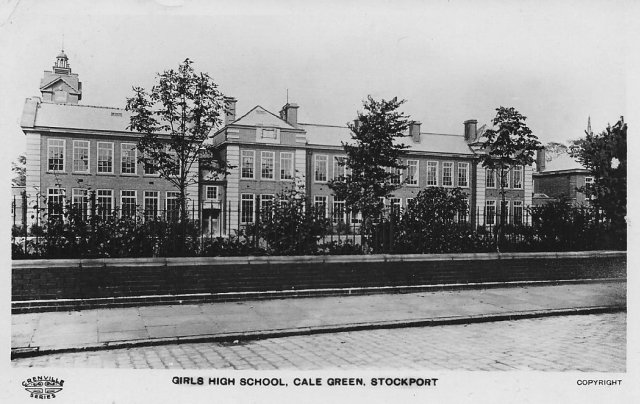
By the late 1890s there was a movement in Britain towards more education for girls, traditionally destined to find a husband and raise children; it was said this change was partly driven by a statistical realisation that there were more females than males in the population. Stockport's first secondary school for girls was founded in 1894 as a private enterprise - Stockport High School for Girls Limited - at 1 Longshut Lane West, at the corner of Longshut Lane West and Wellington Road South. It seems to have expanded to include No. 3 Longshut lane West and 216 Wellington Road South.
A directory of 1896 shows Miss L. L. Johnson as head mistress, but by 1902 she had been replaced as head by Miss Edith Mary Sewell, born in Newcastle-on-Tyne in 1869, daughter of John Sewell who was the first headmaster at Middlesbrough High School for boys which which opened in 1870, and by 1901 was living in retirement with his wife Hannah at North Langrigge, Bowness-on-Windermere. The 1911 census has Miss Sewell living and 54 Edenhurst Road, Mile End, Stockport with her housekeeper Mabel Annie Dewdney, daughter of a Solicitor's Clerk from London. She served as headmistress until her retirement in 1925, when she moved to Switzerland, reportedly living in a house once used by famous art critic John Ruskin. She later returned to Britain where she died in Hastings in 1955.
Stockport Council took over the school in 1903, and plans were made for a new purpose-built school on a larger site. The site chosen, purchased from Henry Bell for £2457, was the last remaining part of Cale Green Farm, including the site of the farmhouse. The traditional 'cutting the first sod' ceremony took place in the field adjoining the old farmhouse on 27 March 1909, conducted by Edith's father John Sewell assisted by six-year-old Phyllis Thornely whose grandmother Sarah Barbara Thornely was a daughter of Charles Robert Brady, and had lived in the farmhouse fifty years earlier. ( Note: the spelling of the name Thornely is given as Thorniley or Thornley in some records. We have used the version written by Mrs Thornely herself in the 1911 census.)
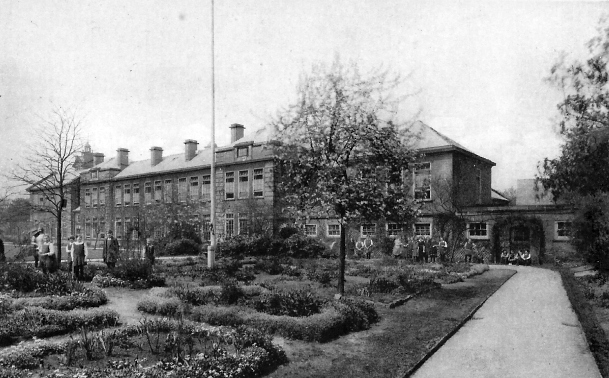
The new school building in red facing brick and Darley Dale stone, which cost £14,561 plus £1,160 for furniture, was designed by London-based architects Spalding and Spalding, who specialised in school work. The partners were Henry Spalding (1839-1910) and his son Reginald H Spalding. Henry Spalding, with an earlier partner Alfred William Stephens Cross, had designed the Technical School building in Sackville Street, Manchester, which later became the main building of UMIST. The private Stockport Grammar School on the Buxton Road in Davenport, opened in 1916 to replace an older building Stockport town centre, was also a Spalding and Spalding design. Henry Spalding never saw either school building completed as he died in 1910. A young architect, Ernest Theakston of London, was also involved in the work at Cale Green.
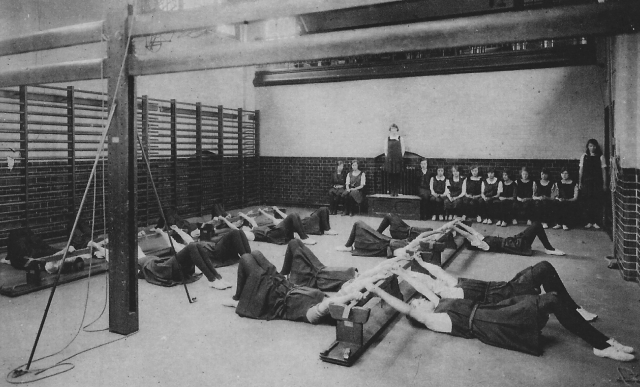
An advertisement in the Stockport Advertiser of 3 August 1910 announced that the new building would open in the Autumn Term, and the headmistress would be at the school from 17 September to admit new pupils. A formal opening ceremony took place on 13 October; Henry Bell junior, described as 'one of those connected with the early history of the ... school' was there to make an encouraging speech. Although a council-run school, parents were required to contribute financially. The school operated successfully for many years; 'Heathfield' and its playing fields were added to the school in 1946. A pupil who became something of a celebrity was Joan Bakewell, later a TV presenter, who served as Head Girl. She told the press in 2012: 'The school was staggeringly strict, with many rules, so I wasn’t much of a rebel. I was once given detention for talking too much, and had to write "I must not talk in class" 100 times.' Memories of life at the school in wartime inspired her novel All the Nice Girls whose plot is inspired by the true story of how. during World War II, the school 'adopted' a ship.
By the 1970s, however, with the so-called 'post-war boom' over, and grammar schools no longer in fashion, it was decided that the Cale Green school would be merged with Fylde Lodge school.
Fylde Lodge had originally been founded as a private school in 1893 by the Misses E.J. and L.H Sales in a house of that name which stood on the corner of Priestnall and Mauldeth Roads. and It was taken over by Stockport Council in 1922. Over the years extra buildings were built in the grounds. In two phases, between 1959 and 1966 a completely new school was built on a 'green field' site to the west, north of Priestnall Road, part of which had been used for allotment gardens. Its history is well chronicled in a website maintained by former pupils.In a booklet prepared for the 1974 departure from Cale Green there is mention of a table, still in existence at that time, in the school which was 'made from a pear tree that had grown on the old site, incorporating timber from the old farm'. Could it be that this table has survived?
The Cale Green site was then used as Davenport Lower School. It housed the lower forms of Davenport School, which was built on Highfield Close, Davenport in the 1960s on a site which is now a housing estate.
An advertisement for a 'Head of Lower School' published in 1975 states that 'Davenport Lower School is three-quarters of a mile from the Upper School [in Highfield Close]. The head of the Lower School will be completely responsible for the day-to-day running of the Lower School, and will be a member of the school policy-making team.' The post was to commence in September 1975. That was the era of the so-called post-war 'baby boom' and it would seem that even the brand-new Davenport School had proved inadequate. A few years later, the division became unnecessary and the school operated solely, with extensions at the Highfield Close building, which eventually became redundant and closed in August 1989.
The Davenport (Upper) School building on Highfield Close was then taken over by Stockport College, its 1960s fabric slowly deteriorating, before final abandonment and demolition c. 2000. The site of the buildings was sold for housing, raising money for a extra building at the College's main site in Stockport which opened in 2005. The extensive playing fields at Highfield Close were retained for public use.In 1983 the main High School buildings at Cale Green were sold to Hillcrest Grammar School. Hillcrest was originally a preparatory school for boys, established in 1940 in a house, no. 15 Hillcrest Road, Bramhall, which gained large extensions to the rear over the years as it became an fee-paying co-educational grammar school in the 1950s. (The original house, was returned to residential condition, and in 2025 bears the name 'The Old School House.')
The school flourished for a while in its new much larger home, expanding into the area between the school and Heath Road, including the site of the lost house 'The Homestead' and four other houses which were bought and demolished; a sports hall with four badminton courts was built in 1994 and a pre-preparatory department in 2003. A new Preparatory Building with facilities for the Nursery was opened by Olympic Swimmer Michael Rock in October 2009.
However, turbulence in the country's economy and changes in the provision of education in the new century, including the appearance of state-funded 'free schools' and 'academies' led to financial problems for privately-run schools as parents' willingness to may up to £3000 per term declined. Nearby Oriel Bank School closed its doors in 2005, and by 2014 Hillcrest was in trouble. Attempts were made during 2014 to register it as a 'free school' which would be funded by the government, while still describing itself on its website as 'one of the strongest small Schools in Stockport.' Free school status was not granted, however, and an option was explored to merge with another privately-run Independent, Hulme Hall Grammar School in Cheadle Hulme, the merged school to operate from the Cheadle Hulme site. The press were told that Hillcrest’s site will be sold and money raised will be invested in the new school' but although some pupils transferred to Hulme Hall the merger idea foundered and Hillcrest closed its doors, with the loss of 26 Jobs. A factor may have been that the building is a locally-listed building in a Conservation area, and permission to sell for housing would have been hard to obtain.
Meanwhile, in 2013, further education establishment Stockport College had created its own Free School called Stockport Technical School, with a mission to 'offer vocational and academic courses for students aged 14 to 19'. Initially it operated in an office building, while preparing a plan to take over the Hillcrest site, with Government funding. In 2015 the site and buildings were bought by the Department of Education for two million pounds. However, the Technical School had failed to attract a viable number of pupils, and instead it closed in 2015, leaving the Cale Green site still 'mothballed. ' Finally, in 2016, the management of Hulme Hall Grammar School decided to leave the Cheadle Hulme buildings and move their operation 'lock, stock and barrel' to the Cale Green site, a move completed in September 2017. The school was officially opened on 8 September by the a famous pupil of the Hugh School for Girls, Baroness Joan Bakewell.
The name 'Hulme Hall' comes from an old timber-framed building on Hulme Hall Road opposite the school's former Cheadle Hulme site, the oldest parts of which have been dated to the fifteenth century. It was an ancestral home of the Vernon family, and later the Moseleys. There are, or were, several other Hulme Halls in the Cheshire and Lancashire area. Unfortunately none of them are connected with the author of this article.
Written by Charlie Hulme, March 2018. Last update August 2025.
Comments welcome at info@davenportstation.org.uk